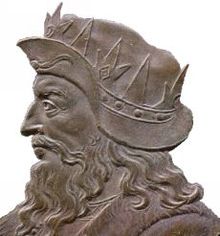Chlodio
This article needs additional citations for verification. (May 2010) |
| Chlodio | |||||
|---|---|---|---|---|---|
| King of the Salian Franks | |||||
 Chlodio | |||||
| Born | c. 392/395[1] | ||||
| Died | 445[1]/448 (~aged 50) | ||||
| Consort | Basina (daughter of Wedelphus, an alleged king of the Thuringii) [1] | ||||
| Issue | Merovech (disputed) | ||||
| |||||
| Father | Theudemeres | ||||
| Mother | Argotta (disputed) | ||||
Chlodio (c. 392/395[1]–445[1]/448; also spelled Clodio, Clodius, Clodion, Cloio or Chlogio) was a king of the Salian Franks from the Merovingian dynasty. He was known as the Long-Haired King and lived in Thuringian territory, at the castle of Duisburg. He became chief of the Thérouanne area in 414 AD. From there, he invaded the Roman Empire in 428, defeating a Roman force at Cambrai, and settled in Northern Gaul, where other groups of Salians were already settled. Although he was attacked by the Romans, he was able to maintain his position and, 3 years later in 431, he extended his kingdom south to the Somme River in the future Francia. In AD 448, 20 years after his reign began, Chlodio was defeated at Vicus Helena in Artois[2] by Flavius Aëtius, the commander of the Roman army in Gaul.
Like all Merovingian kings, Chlodio had long hair as a ritual custom. His successor may have been Merovech, after whom the dynasty was named 'Merovingian'. The non-contemporary Liber Historiae Francorum says his father was Pharamond, whom many believe to have been a legendary person linked to the lineage sometime in the 8th century. The Chronicle of Fredegar makes Chlodio son of Theudemeres, one of the leaders of the Salian Franks and king of Thérouanne (409–414).
References
Sources
External links
- Stirnet: Franks1 (subscription required)
- Stirnet: Franks2 (subscription required)


